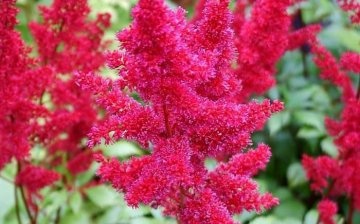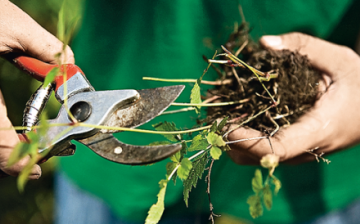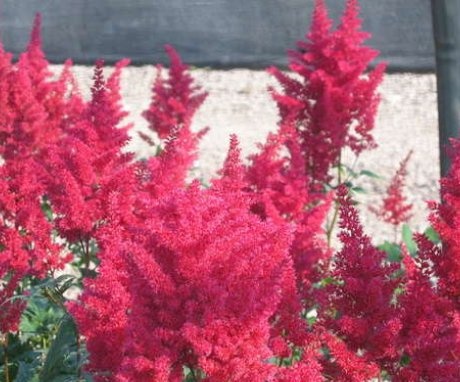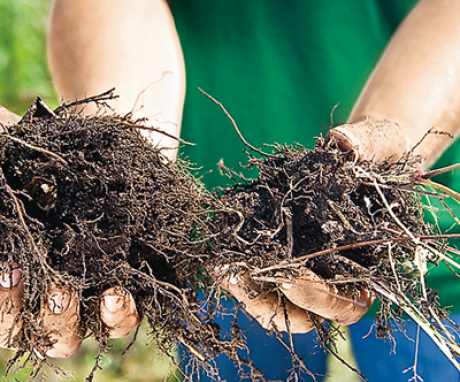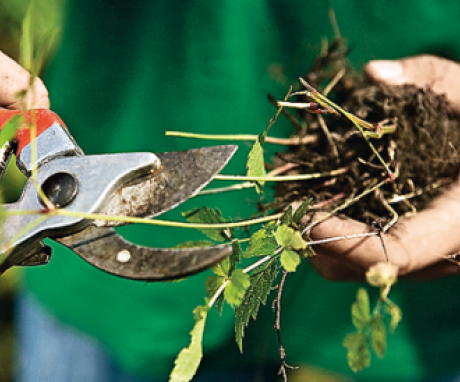Astilba Ardens: features of growing a bush
Representatives of the Astilba genus are widely used in landscape design because of the magnificent lush inflorescences and bright greenery. These are herbaceous tall plants of the Saxifrage family with an erect stem and high peduncles; today there are about twenty species of astilbe in total. Many of them are cultivated for ornamental purposes, but the most common is Astilba Ardens. She has gorgeous bright flowers and can be a decoration for any garden.
Content
General view of the plant and origin
Astilbe Ardens is powerful herb, whose height reaches 1 meter. It is one of the perennials, capable of growing in one place for at least 10-15 years.
Characteristics:
- The plant has a strong root system and numerous erect shoots with many dark green leaves.
- The leaves have a complex cut shape, when blooming, they are characterized by a brownish-red hue.
- In autumn, they turn yellow and gradually crumble. The width of the bush is approximately 60-100 cm.
- The type of inflorescence is a panicle, they can be large in size and differ in color, depending on the selected variety.
- It can be white, light pink, dark pink, carmine, or red.
- The inflorescences are fragrant, this is one of the reasons to plant Astilba Ardens on the site.
- Peduncle height can reach 160 cm, flowers begin to appear at the end of June, and lush flowering can continue until August.
This species was bred artificially, it does not grow in the wild.
The name Ardens actually unites several hybrid forms of other species, which were formed as a result of successive crosses, which were carried out by a German breeder named Ardens. The basis for the new hybrid species was Astilba David, crosses were carried out with both cultivated and wild varieties.
As a result, it was possible to obtain a plant that has the hardiness of a wild-growing species with excellent decorative qualities.
Astilba Ardens is a winter-hardy plant, therefore it can be grown in the conditions of central Russia. However, it is sensitive to strong winds, so it is advisable to shelter it for the cold season.
Basic rules for growing
This type of Astilba has always attracted gardeners due to its endurance and unpretentiousness, and its beautiful appearance. It will not be very difficult to plant and grow it, and in response to worries, the plant will delight its owner with annual lush flowering.
To get healthy and strong shoots, you need to follow the following growing rules:
- Accommodation. Astilba does not like high temperatures, so it should not be planted in the open sun. Better to choose a shade or partial shade, it is desirable that the area is humid. This plant adapts perfectly in areas with close groundwater occurrence.
- The soil. It is preferable to choose fertile loamy soils rich in humus. On depleted soils, astilbe grows poorly, it will have to be fed several times.The soil should be slightly acidic or neutral; this species practically does not grow on alkaline soils.
- Watering. The plant loves water, the soil must always be at least slightly moistened. Astilbe tolerates drought very badly: the stems weaken, it can die very quickly.
- Special conditions for growth. Astilba survives the winter well enough and is not afraid of early frosts. If the plant shoots in the same place for many years, over time, the inflorescences will begin to shrink. This is due to soil depletion and some other factors, therefore, Astilba is recommended to be repotted periodically. New shoots will appear quickly, usually there are no problems with rooting.
Astilbe Ardens is ideal for creating decorative compositions.
Since she loves wet places, she is often decorated with the banks of artificial reservoirs. In addition, e can use in decorative compositions along the tracks.
Reproduction of Astilba Ardens
This plant can multiply by seed or vegetatively. The first option is more often used in selective breeding, since it allows you to get non-standard color options for inflorescences. In addition, seeds can be grown to seedling condition before being moved outdoors.
If seed cultivation is supposed, mandatory stratification of the material is carried out before sowing: the seeds must be kept at zero temperature, this will significantly improve germination.
For seedlings, seeds are sown in February or early March, the first shoots will appear in 2-3 weeks, while sowing must be carried out without deepening the seeds into the soil. In early summer, the sprouts can be transplanted into open ground. If it is planned to sow seeds directly into open ground, then it is carried out before winter, and the first shoots will appear in the spring.
Vegetative propagation of the bush is much easier. The shrub is usually divided either in early summer or in August, at the end of the flowering period.
Basic transplant rules:
- The rhizome is divided into several parts with a knife or garden shovel. Growth will begin at the expense of its upper parts, so the lower parts of the rhizome can be removed.
- You need to transplant shoots right away after dividing the bushotherwise the roots may dry out.
- Shoots with parts of the rhizome are placed in a soil consisting of sod land, peat and coarse sand. At the base of the kidney, it is necessary to compact the soil.
- The transplanted plant must be placed in a shaded area, complete rooting will occur in about two to three weeks. This requires moderate but regular watering.
- When transplanted correctly, the divided plant will very quickly begin to produce young shoots.
- Astilba Ardens tolerates a transplant, and it will only benefit her.
- Stronger peduncles appear on young shoots, so the inflorescences will be larger and brighter.
- Experienced gardeners advise transplanting every few years to avoid inflorescences becoming smaller.
In general, Astilba Ardens remains an unpretentious plant for which you can quickly find a suitable place on the site. The bush will delight the eye with a lush constant flowering, it can become a real decoration any adjoining territory. Having mastered the handling of this hybrid species, it will be possible to experiment with other varieties of Astilba, which can form very interesting compositions.
More information can be found in the video.



